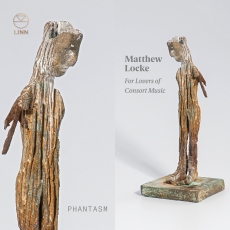Phantasm - Locke - Fanfare (JD)
Sixteen years after Brian Robins reviewed Phantasm’s GMN recording of virtually this identical program in 25:2, the widely acclaimed British viol consort Phantasm decided to pay Matthew Locke and his consort suites a second visit, this time with a couple of differences from the ensemble’s previous account. One difference involves nothing more than two spelling modernizations. The old English “Fowr” in “Consort of Fowr Parts” has been dropped in favor of the modern English “Four”; and “Flatt” in “Flatt Consort” has been updated to the modern English “Flat.” If, perchance, the title “Flat Consort” conjures for you the image of a bass viol run over by a steamroller, rest assured that in this context “flat” refers to no such thing. Cousin Kemble, it seems, suffered from aichmophobia, a fear of sharp things, so the 10 suites Locke wrote for him under the title “Flatt Consort for my cousin Kemble” are all in “flatt keyes.” Second, and more consequentially, Phantasm has added almost 20 minutes of music to its new Linn album by including three works not on its previous CD: the Second Suite from the Flat Consort and two canons, one based on a plainsong, the other based on a hexachord.
Music for consorts (a synonym for “ensembles” or “groups”) of viols was a particularly English pastime that engaged the talents of a number of composers and players for about 100 years, from approximately 1575 to 1675. Famous names among contributors to the repertoire were William Byrd (1540—1623), Thomas Morley (1557—1602), John Dowland (1563—1626), Orlando Gibbons (1583—1625), John Jenkins (1592—1678), and the Lawes brothers, Henry (1595—1662) and William (1602—1645). In this line of distinguished viol players, lutenists, song makers, and composers of sacred choral works, Matthew Locke (1621—1677) brought up the rear guard. If not absolutely the last composer to devote attention to the viol consort literature, he was very close to it. The reason for the genre’s gradual demise after about the middle of the 17th century can be attributed to an eviction notice. The family of viol instruments was being dislodged from the premises by a new family in the neighborhood, the violin and its kin.
Like the Consort Music of Four Parts by John Jenkins, which I reviewed on a recording by Fretwork in 42:1, Locke’s Suites for Four-Part Consort are also a bit unusual in that the general rule for much of the viol consort literature calls for five or six parts. The typical consort of viols of the period, according to Thomas Mace (1612/13—c. 1706), a lutenist, viol player, singer, composer, and early Baroque music theorist, was composed of six instruments: two basses, two tenors, and two trebles, or one bass, three tenors, and two trebles. That Jenkins and Locke both date from near the end of the viol consort’s run, and that both of them gravitated towards writing in four parts instead of the more traditional five or six could—and I emphasize the conditional—have planted the seeds for the string quartet.
Phantasm’s most familiar, though not only, competitor in this body of viol consort literature is, of course, Fretwork, which also recorded almost exactly this same program for Virgin Classics back in 1996. Fretwork’s accounts are a bit different, though, in that Paul Nicholson supplies the optional supporting continuo part alternately on spinet and organ, while Phantasm’s Elizabeth Kenny supplies the supporting continuo on theorbo.
As with the viol consort works of all the above-named composers, there are differing levels of sophistication and variations in refinement of technique, to be sure, but overall, the consistency of style and quality is very high. Dating from the mid-1650s, Locke’s suites, historically, belong to the Baroque, and their dance movements, manner of contrapuntal manipulation, frequent flights of fantasy, and generally tonal, as opposed to modal, harmonic progressions and cadences confirm their chronology. But there’s a timeless beauty to this music that reverberates in the air with the voice and spirit of the late Renaissance. It’s strangely sad and haunting in a way, yet somehow of an enveloping, caressing comfort.
Beautifully played, attentively recorded, and definitely recommended.


